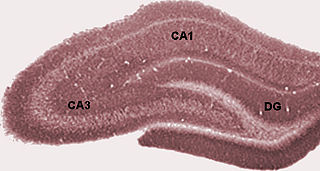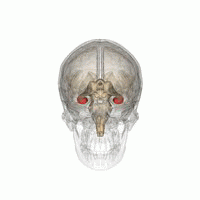Related Research Articles

The hippocampus, also hippocampus proper, is a major component of the brain of humans and many other vertebrates. In the human brain the hippocampus, the dentate gyrus, and the subiculum are the components of the hippocampal formation located in the limbic system. The hippocampus plays important roles in the consolidation of information from short-term memory to long-term memory, and in spatial memory that enables navigation. In humans, and other primates the hippocampus is located in the archicortex, one of the three regions of allocortex, in each hemisphere with neural projections to the neocortex. The hippocampus, as the medial pallium, is a structure found in all vertebrates.

The limbic system, also known as the paleomammalian cortex, is a set of brain structures located on both sides of the thalamus, immediately beneath the medial temporal lobe of the cerebrum primarily in the forebrain.

An androgen is any natural or synthetic steroid hormone that regulates the development and maintenance of male characteristics in vertebrates by binding to androgen receptors. This includes the embryological development of the primary male sex organs, and the development of male secondary sex characteristics at puberty. Androgens are synthesized in the testes, the ovaries, and the adrenal glands.

The dentate gyrus (DG) is one of the subfields of the hippocampus, in the hippocampal formation. The hippocampal formation is located in the temporal lobe of the brain, and includes the hippocampus subfields, and other subfields including the dentate gyrus, subiculum, and presubiculum.

Adult neurogenesis is the process in which neurons are generated from neural stem cells in the adult. This process differs from prenatal neurogenesis.
Joseph Altman was an American biologist who worked in the field of neurobiology.

The subventricular zone (SVZ) is a region situated on the outside wall of each lateral ventricle of the vertebrate brain. It is present in both the embryonic and adult brain. In embryonic life, the SVZ refers to a secondary proliferative zone containing neural progenitor cells, which divide to produce neurons in the process of neurogenesis. The primary neural stem cells of the brain and spinal cord, termed radial glial cells, instead reside in the ventricular zone (VZ).

Pasko Rakic is a Yugoslav-born American neuroscientist, who presently works in the Yale School of Medicine Department of Neuroscience in New Haven, Connecticut. His main research interest is in the development and evolution of the human brain. He was the founder and served as Chairman of the Department of Neurobiology at Yale, and was founder and Director of the Kavli Institute for Neuroscience. He is best known for elucidating the mechanisms involved in development and evolution of the cerebral cortex. In 2008, Rakic shared the inaugural Kavli Prize in Neuroscience. He is currently the Dorys McConell Duberg Professor of Neuroscience, leads an active research laboratory, and serves on Advisory Boards and Scientific Councils of a number of Institutions and Research Foundations.

The subgranular zone (SGZ) is a layer of cells in the dentate gyrus, in the hippocampal formation, which is a site of adult neurogenesis in the brain.
Radiation-induced cognitive decline describes the possible correlation between radiation therapy and cognitive impairment. Radiation therapy is used mainly in the treatment of cancer. Radiation therapy can be used to cure, care or shrink tumors that are interfering with quality of life. Sometimes radiation therapy is used alone; other times it is used in conjunction with chemotherapy and surgery. For people with brain tumors, radiation can be an effective treatment because chemotherapy is often less effective due to the blood–brain barrier. Unfortunately for some patients, as time passes, people who received radiation therapy may begin experiencing deficits in their learning, memory, and spatial information processing abilities. The learning, memory, and spatial information processing abilities are dependent on proper hippocampus functionality. Therefore, any hippocampus dysfunction will result in deficits in learning, memory, and spatial information processing ability.
The trisynaptic circuit or trisynaptic loop is a relay of synaptic transmission in the hippocampus. The trisynaptic circuit is a neural circuit in the hippocampus, which is made up of three major cell groups: granule cells in the dentate gyrus, pyramidal neurons in CA3, and pyramidal neurons in CA1. The hippocampal relay involves three main regions within the hippocampus which are classified according to their cell type and projection fibers. The first projection of the hippocampus occurs between the entorhinal cortex (EC) and the dentate gyrus (DG). The entorhinal cortex transmits its signals from the parahippocampal gyrus to the dentate gyrus via granule cell fibers known collectively as the perforant path. The dentate gyrus then synapses on pyramidal cells in CA3 via mossy cell fibers. CA3 then fires to CA1 via Schaffer collaterals which synapse in the subiculum and are carried out through the fornix. Collectively the dentate gyrus, CA1 and CA3 of the hippocampus compose the trisynaptic loop.

Hippocampus anatomy describes the physical aspects and properties of the hippocampus, a neural structure in the medial temporal lobe of the brain. It has a distinctive, curved shape that has been likened to the sea-horse monster of Greek mythology and the ram's horns of Amun in Egyptian mythology. This general layout holds across the full range of mammalian species, from hedgehog to human, although the details vary. For example, in the rat, the two hippocampi look similar to a pair of bananas, joined at the stems. In the human and other primates, the portion of the hippocampus near the base of the temporal lobe is much broader than the part at the top. Due to the three-dimensional curvature of this structure, two-dimensional sections such as shown are commonly seen. Neuroimaging pictures can show a number of different shapes, depending on the angle and location of the cut.

The name granule cell has been used for a number of different types of neurons whose only common feature is that they all have very small cell bodies. Granule cells are found within the granular layer of the cerebellum, the dentate gyrus of the hippocampus, the superficial layer of the dorsal cochlear nucleus, the olfactory bulb, and the cerebral cortex.
Endogenous regeneration in the brain is the ability of cells to engage in the repair and regeneration process. While the brain has a limited capacity for regeneration, endogenous neural stem cells, as well as numerous pro-regenerative molecules, can participate in replacing and repairing damaged or diseased neurons and glial cells. Another benefit that can be achieved by using endogenous regeneration could be avoiding an immune response from the host.

The hippocampus is an area of the brain integral to learning and memory. Removal of this structure can result in the inability to form new memories as most famously demonstrated in a patient referred to as HM. The unique morphology of the hippocampus can be appreciated without the use of special stains and this distinct circuitry has helped further the understanding of neuronal signal potentiation. The following will provide an introduction to hippocampal development with particular focus on the role of glucocorticoid signaling.
Neurogenesis is the process by which nervous system cells, the neurons, are produced by neural stem cells (NSCs). This occurs in all species of animals except the porifera (sponges) and placozoans. Types of NSCs include neuroepithelial cells (NECs), radial glial cells (RGCs), basal progenitors (BPs), intermediate neuronal precursors (INPs), subventricular zone astrocytes, and subgranular zone radial astrocytes, among others.
Attila Losonczy is a Hungarian neuroscientist, Professor of Neuroscience at Columbia University Medical Center. Losonczy's main area of research is on the relationship between neural networks and behavior, specifically with regard to learning in the hippocampus.
Liisa Ann Margaret Galea is a Canadian neuroscientist who is a professor of psychology at the University of British Columbia. She is a member of the Centre for Brain Health and Director of the Graduate Programme in Neuroscience. Her research considers the impact of hormones on brain health and behaviour.

Adult neurogenesis is the process by which functional, mature neurons are produced from neural stem cells (NSCs) in the adult brain. In most mammals, including humans, it only occurs in the subgranular zone of the hippocampus, and in the olfactory bulb. The neurogenesis hypothesis of depression proposes that major depressive disorder is caused, at least partly, by impaired neurogenesis in the subgranular zone of the hippocampus.

Heather A. Cameron is an American neuroscientist who researches adult neurogenesis and diseases involving the hippocampus. She is the chief of the neuroplasticity section at the National Institute of Mental Health.
References
- 1 2 3 Specter, Michael (July 23, 2001). "Rethinking the Brain How the songs of canaries upset a fundamental principle of science". Michael Specter. The New Yorker. Retrieved 28 September 2018.
- ↑ "Elizabeth Gould, Ph.D." Brain and Behavior. 2017-04-03. Retrieved 28 September 2018.
- ↑ "Elizabeth Gould". Princeton Neuroscience Institute. Retrieved 28 September 2018.
- 1 2 3 Epp, Jonathan R.; Chow, Carmen; Galea, Liisa A. M. (16 April 2013). "Hippocampus-dependent learning influences hippocampal neurogenesis". Frontiers in Neuroscience. 7: 57. doi: 10.3389/FNINS.2013.00057 . ISSN 1662-453X. PMC 3627134 . PMID 23596385. Wikidata Q36768019.
- ↑ Kempermann, Gerd; Gage, Fred H.; Aigner, Ludwig; et al. (19 April 2018). "Human Adult Neurogenesis: Evidence and Remaining Questions". Cell Stem Cell . 23 (1): 25–30. doi:10.1016/J.STEM.2018.04.004. ISSN 1934-5909. PMC 6035081 . PMID 29681514. Wikidata Q52804530.
- ↑ Andreae, Laura C. (11 April 2018). "Adult neurogenesis in humans: Dogma overturned, again and again?". Science Translational Medicine . 10 (436): eaat3893. doi:10.1126/SCITRANSLMED.AAT3893. ISSN 1946-6234. Wikidata Q64385753.
- ↑ Svitil, Kathy (1 November 2002). "The 50 Most Important Women in Science". Discover. Retrieved 21 December 2014.
- ↑ Cameron, H.A.; Gould, E. (July 1994). "Adult neurogenesis is regulated by adrenal steroids in the dentate gyrus". Neuroscience. 61 (2): 203–209. doi:10.1016/0306-4522(94)90224-0. PMID 7969902. S2CID 16297590.
- ↑ Gould, Elizabeth; Reeves, Alison J.; Graziano, Michael S. A.; Gross, Charles G. (October 1999). "Neurogenesis in the Neocortex of Adult Primates". Science. 286 (5439): 548–552. doi:10.1126/science.286.5439.548. PMID 10521353. S2CID 14687148.
- ↑ Woolley, Catherine S. (2007). "Estrogen and synapses in the hippocampus". In Bear, Mark F.; Connors, Barry W.; Paradiso, Michael A. (eds.). Neuroscience : exploring the brain (Fourth ed.). Baltimore, MD: Lippincott Williams & Wilkins. p. 558. ISBN 978-1451109542.
{{cite book}}:|journal=ignored (help) - 1 2 3 "NARSAD Grantees at the Leading Edge: A Quarter-Century of Groundbreaking Discoveries about the Brain's Plasticity". Brain and Behavior. October 22, 2013. Retrieved 28 September 2018.
- ↑ Rakic, P (1 February 1974). "Neurons in rhesus monkey visual cortex: systematic relation between time of origin and eventual disposition". Science. 183 (4123): 425–7. Bibcode:1974Sci...183..425R. doi:10.1126/science.183.4123.425. PMID 4203022. S2CID 10881759.
- ↑ Snyder, Jason (March 7, 2018). "WTF! No neurogenesis in humans??". The Snyder Lab. Retrieved 28 September 2018.
- 1 2 3 4 Lehrer, Jonah (2006). "The reinvention of self" (PDF). SEED. No. February/March. p. 63. Retrieved 28 September 2018.
- ↑ Kornack, DR; Rakic, P (11 May 1999). "Continuation of neurogenesis in the hippocampus of the adult macaque monkey". Proceedings of the National Academy of Sciences of the United States of America. 96 (10): 5768–73. Bibcode:1999PNAS...96.5768K. doi: 10.1073/pnas.96.10.5768 . PMC 21935 . PMID 10318959.
- 1 2 "Elizabeth Gould". Princeton University. Retrieved 31 July 2017.
- ↑ Tanapat, Patima; Hastings, Nicholas B.; Gould, Elizabeth (17 January 2005). "Ovarian steroids influence cell proliferation in the dentate gyrus of the adult female rat in a dose- and time-dependent manner". The Journal of Comparative Neurology. 481 (3): 252–265. doi:10.1002/cne.20385. PMID 15593136. S2CID 16185380.
- ↑ Leuner, B.; Kozorovitskiy, Y.; Gross, C. G.; Gould, E. (16 October 2007). "Diminished adult neurogenesis in the marmoset brain precedes old age". Proceedings of the National Academy of Sciences. 104 (43): 17169–17173. Bibcode:2007PNAS..10417169L. doi: 10.1073/pnas.0708228104 . PMC 2040400 . PMID 17940008.
- ↑ Gould, E; McEwen, BS; Tanapat, P; Galea, LA; Fuchs, E (1 April 1997). "Neurogenesis in the dentate gyrus of the adult tree shrew is regulated by psychosocial stress and NMDA receptor activation". The Journal of Neuroscience . 17 (7): 2492–2498. doi:10.1523/JNEUROSCI.17-07-02492.1997. ISSN 0270-6474. PMC 6573503 . PMID 9065509. Wikidata Q64385755.
- ↑ Opendak, Maya; Gould, Elizabeth (March 2015). "Adult neurogenesis: a substrate for experience-dependent change". Trends in Cognitive Sciences. 19 (3): 151–161. doi:10.1016/j.tics.2015.01.001. PMID 25715908. S2CID 16384656.
- ↑ Lieberwirth, Claudia; Wang, Zuoxin (2012). "The Social Environment and Neurogenesis in the Adult Mammalian Brain". Frontiers in Human Neuroscience. 6: 118. doi: 10.3389/fnhum.2012.00118 . PMC 3347626 . PMID 22586385.
- ↑ Leuner, Benedetta; Gould, Elizabeth (January 2010). "Structural Plasticity and Hippocampal Function". Annual Review of Psychology. 61 (1): 111–140. doi:10.1146/annurev.psych.093008.100359. PMC 3012424 . PMID 19575621.
- ↑ LaDage, Lara D. (September 2015). "Environmental Change, the Stress Response, and Neurogenesis: Fig. 1". Integrative and Comparative Biology. 55 (3): 372–383. doi: 10.1093/icb/icv040 . PMID 25980567.
- ↑ Gould, Elizabeth; Allan, Mark D.; McEwen, Bruce S. (August 1990). "Dendritic spine density of adult hippocampal pyramidal cells is sensitive to thyroid hormone". Brain Research. 525 (2): 327–329. doi:10.1016/0006-8993(90)90884-E. PMID 2253032. S2CID 14935477.
- ↑ GOULD, ELIZABETH (November 1994). "The Effects of Adrenal Steroids and Excitatory Input on Neuronal Birth and Survival". Annals of the New York Academy of Sciences. 743 (1 Hormonal Rest): 73–92. Bibcode:1994NYASA.743...73G. doi:10.1111/j.1749-6632.1994.tb55788.x. PMID 7802420. S2CID 1585142.
- ↑ "Troland Research Awards". National Academy of Science. Retrieved 27 September 2018.
- ↑ "Spring 2009 News in Brief". RSA. Archived from the original on 5 January 2011. Retrieved 28 December 2010.